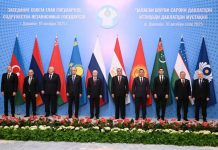The close and long-standing relations between the Tajik and Uzbek peoples are based on the age-old foundations of friendship and unity. Both of these peoples, who developed within the same civilization and often within the same state, formed their own cultural and civilizational characteristics, being in close proximity to each other for many centuries. Such a centuries-old common history contributed to the formation of their deep family ties. The strength of this friendship and brotherhood between Tajiks and Uzbeks is confirmed by history, which is reflected in a popular expression describing Tajiks and Uzbeks as “one people speaking two languages.”
A closer study of the history of Tajik-Uzbek relations reveals many bright and significant moments. This was especially noticeable in the XV century, when the stars of two great personalities — Mawlana Abdurakhman Jami and Mir Alisher Navoi – flashed in the cultural space of Movarounahr and Khorasan. These figures not only left an indelible mark on literature and culture, but also became symbols of intercultural dialogue and fraternity between peoples. Their creativity and ideas of apprenticeship and mastery have inspired the development of friendly and fraternal ties between Tajiks and Uzbeks for centuries, emphasizing the common cultural and spiritual aspirations of the two peoples.
It should be emphasized that Navoi and Jami’s contribution to the history of the Uzbek and Tajik peoples is much broader than just their role as literary figures. They acted not only as creators of literary works, but also as spiritual leaders, cultural symbols, as guiding light for future generations within the framework of friendly Tajik-Uzbek relations. The great will, respect and mutual affection of Navoi and Jami are so significant that Alisher Navoi, developing poetry and literature, wrote poetry in Tajik under the pseudonym Foni, leaving behind the “Foni cabinet” — a bright page in the history of Tajik literature of the XV century. This bilingual tradition continued in the following centuries, when Uzbek poets Fusuli, Ogahi, Amiri and others contributed to the formation of a unique phenomenon in the culture of the peoples of Central Asia — bilingual literature or the Zulu language (literary bilingualism). This phenomenon confirms that Uzbek writers and cultural scientists throughout various historical periods have treated Tajik culture and literature with special respect, using these traditions to enrich their national poetry. The tradition of writing in two languages, Tajik and Uzbek, continued in the XVIII and XIX centuries, making a significant contribution to strengthening friendship between the Tajik and Uzbek peoples.
An additional evidence of the strong roots of Tajik-Uzbek friendship is the fact that most representatives of the intellectuals of both peoples in the XVIII-XIX and early XX centuries were fluent in Tajik and Uzbek languages, actively wrote and read in these languages. A vivid reflection of this bilingual culture was the appearance of newspapers and magazines, such as the Zarafshon newspaper and the Turon magazine, in the late XIX and early XX centuries on the territory of the Bukhara Emirate and Russian Turkestan. In addition, in the second half of the twentieth century, education in schools in Central Asia was conducted in both languages, which confirms the long-term commitment to bilingual education.
S. Aini, a famous literary and cultural figure, opened a new chapter in the history of friendship between the Tajik and Uzbek peoples at the beginning of the 20th century. His appearance on the historical stage coincided with a key period for both peoples, when he assumed the role of the builder of a new civilization. Especially after the October Revolution, S. Aini not only wrote in Tajik and Uzbek, but also actively engaged in teaching, mentoring and guiding young people. In the same years, he established fruitful cooperation with such Uzbek writers as Hamza, A. Kadiri and G. Ghulam, which contributed to the development of literature, culture, the press and new education.
Many writers of the first and subsequent generations of Uzbek literature of the 20th century consider S. Aini their teacher and mentor. This tradition was continued by outstanding Uzbek and Tajik writers, including M. Tursunzade, G. Ghulam, J. Ikromi, Zulfiya, Oybek, S. Ulugzoda, M. Mirshakar, B. Rahimzoda, Sh. Rashidova, A. Kadiri, E. Vahidova, M. Kanoat, L. Sherali, A. Arifova and others, who continued to strengthen the tree of friendship between these peoples.
The beginning of a new era in relations between Tajikistan and Uzbekistan occurred during the period of their independence, when the Leader of the nation Emomali Rahmon and the President of Uzbekistan Shavkat Mirziyoyev played key roles in strengthening fraternal ties. Their joint efforts contributed to the rapid development of economic, social and cultural ties between the two States. The important meetings of these leaders held in Dushanbe and Tashkent in recent years have given a powerful impetus to strengthening mutually beneficial cooperation. Today, effective partnership has been established in Tajikistan and Uzbekistan at the level of government structures, as well as through various socio-economic organizations.
At the initiative of the leaders of Tajikistan and Uzbekistan, the introduction of a visa-free regime for citizens of both countries has met with a positive response among the population of Tajikistan and Uzbekistan.
This significant step by the leaders of Tajikistan and Uzbekistan revived the ancient traditions of kinship, friendship and unity between the peoples of both countries and opened up new opportunities for deepening trade, economic, cultural and spiritual ties. As a result, today the interaction between these two neighboring, friendly and fraternal republics has reached the level of a real strategic partnership promising a bright future for the development of both countries. An example of such strategic cooperation is the creation of free economic zones, joint border markets and direct links between cities and districts of Tajikistan and Uzbekistan. Tajikistan and Uzbekistan have significant potential to strengthen a multidimensional partnership, which they plan to actively implement.
FARZONAI SHAMSIDDIN.TEACHER, FACULTY OF INTERNATIONAL RELATIONS, TNU




